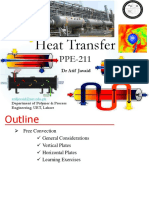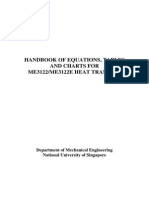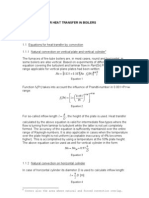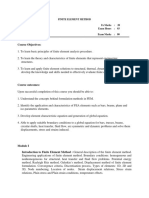ENME 332, Spring 2013 Transfer Processes: Instructors: Reinhard Radermacher & Bao Yang
Uploaded by
Zain BaqarENME 332, Spring 2013 Transfer Processes: Instructors: Reinhard Radermacher & Bao Yang
Uploaded by
Zain BaqarENME 332, Spring 2013
TRANSFER PROCESSES
I nstructors:
Reinhard Radermacher & Bao Yang
1
Todays Agenda:
1. Review on I nternal Flow:
2. Free (or Natural) convection
2
General Considerations and Results for
Vertical and Horizontal Plates
General Considerations
General Considerations
Free convection refers to fluid motion induced by buoyancy forces.
Buoyancy forces may arise in a fluid for which there are density gradients
and a body force that is proportional to density.
In heat transfer, density gradients are due to temperature gradients and the
body force is gravitational.
Stable and Unstable Temperature Gradients
General Considerations (cont.)
Free convection flow:
Bounded flow : flow not bounded by a surface
Free Boundary Flows: flow not bounded by a surface
Occur in an extensive (in principle, infinite), quiescent (motionless
at locations far from the source of buoyancy) fluid.
Plumes and Buoyant J ets:
Free Convection Boundary Layers
Boundary layer flow on a hot or cold surface induced
by buoyancy forces.
( )
s
T T
General Considerations (cont.)
Pertinent Dimensionless Parameters
Grashof Number:
( )
3
2
Buoyancy Force
Viscous Force
s
L
g T T L
Gr
=
Rayleigh Number:
( )
3
s
L L
g T T L
Ra Gr Pr
= =
characteristic length of surface L
(a ther ther mody mal expa namic pr nsion coefficien operty of the fl d) t ui
1
| |
=
|
\ .
p
T
Liquids: Tables A.5, A.6
( ) Ideal Gas: 1/ K T =
[K
-1
]
General Considerations (cont.)
Mixed Convection
A condition for which forced and free convection effects are comparable.
Exists if
( )
2
/ 1
L L
Gr Re
( )
2
- Free convection / 1
L L
Gr Re >>
( )
2
- Forced convection / 1
L L
Gr Re <<
Heat Transfer Correlations for Mixed Convection:
n n n
FC NC
Nu Nu Nu
assisting and transverse flows
- opposing flows
+
3 n
Nu
FC
Nusselt number for forced convection
Nu
NC
Nusselt number for natural (free) convection
Vertical Plates
Vertical Plates
Free Convection Boundary Layer Development on a Hot Plate:
Ascending flow with the maximum velocity occurring in the boundary layer
and zero velocity at both the surface and outer edge.
How do conditions differ from those associated with forced convection?
How do conditions differ for a cold plate ( )?
s
T T
<
x-component velocity temperature
Vertical Plates (cont.)
Form of the x-Momentum Equation for Laminar Flow
( )
2
2
u u u
u g T T
x y y
+ = +
Net Momentum Fluxes
( Inertia Forces)
Buoyancy Force Viscous Force
Temperature dependence requires that solution for u (x,y) be obtained
concurrently with solution of the boundary layer energy equation for T (x,y).
2
2
T T T
u v
x y y
+ =
The solutions are said to be coupled.
Boundary Layer Equations
Vertical Plates (cont.)
Similarity Solution
Based on existence of a similarity variable, through which the x-momentum
equation may be transformed from a partial differential equation with two-
independent variables ( x and y) to an ordinary differential equation expressed
exclusively in terms of .
,
1/ 4
4
x
Gr y
x
| |
|
\ .
Transformed momentum and energy equations:
( )
2
3 2 0 f ff f T
+ + =
* *
3 0 T Pr fT
+ =
( )
( )
1/ 2
2
x
s
T T df
x
f Gr u T
d T T
Vertical Plates (cont.)
Numerical integration of the equations yields the following results for
( ) and : f T
Velocity boundary layer thickness ( ) 5 for 0.6 Pr >
( )
1/4
1/4
1/4
0.6: 5 7.07
4
x
x
Gr
x
Pr x x
Gr
| |
> = =
|
\ .
dimensionless x-component velocity dimensionless temperature
Vertical Plates (cont.)
Nusselt Numbers
( )
and :
L
x
Nu Nu
( )
1/4 1/4
0
4 4
x x
x
Gr Gr
hx dT
Nu g Pr
k d
=
| | | |
= = =
| |
\ . \ .
( )
( )
( )
1/2
1/4
1/2
0.75
0
0.609 1.221 1.238
Pr
g Pr Pr
Pr Pr
= < <
+ +
1 4
3
L
L
L o
h hdx Nu Nu
L
= =
Transition to Turbulence
Amplification of disturbances
depends on relative magnitudes
of buoyancy and viscous forces.
Transition occurs at a critical
Rayleigh Number.
( )
3
9
, ,
10
s
x c x c
g T T x
Ra Gr Pr
= =
Vertical Plates (cont.)
Empirical Heat Transfer Correlations: Vertical Plates
Laminar Flow
( )
9
10 :
L
Ra <
( )
1/4
4/9
9/16
0.670
0.68
1 0.492/
L
L
Ra
Nu
Pr
= +
(
+
All Conditions:
( )
2
1/6
8/27
9/16
0.387
0.825
1 0.492/
L
L
Ra
Nu
Pr
= +
`
(
+
)
(9.27)
(9.26)
Horizontal Plates
Horizontal Plates
Buoyancy force is normal, instead of parallel, to the plate.
Flow and heat transfer depend on whether the plate is hot or cold and
whether it is facing upward or downward.
Hot Surface Facing Upward or Cold Surface Facing Downward
s
T T
> s
T T
<
( )
1/ 4 4 7
0.54 10 10
L
L L
Nu Ra Ra = < <
( )
1/ 3 7 11
0.15 10 10
L
L L
Nu Ra Ra = < <
where L =A
s
/P. How does depend on L when
1/ 3
?
L L
Nu Ra h
(9.30)
(9.31)
Upper surface
Lower surface
Horizontal Plates (cont.)
Hot Surface Facing Downward or Cold Surface Facing Upward
s
T T
>
s
T T
<
( )
1/5 4 9
0.52 10 10
L
L L
Nu Ra Ra = < <
Why do these conditions yield smaller heat transfer rates than those
for a hot upper surface or cold lower surface?
(9.32)
Problem: Solar Receiver
Problem 9.33: Convection and radiation losses from the surface of a central solar receiver.
FIND: (a) Heat loss and collection efficiency for a prescribed receiver temperature, (b) Effect
of receiver temperature on heat losses and collector efficiency.
Problem: Solar Receiver
Problem 9.33: Convection and radiation losses from the surface of a
central solar receiver.
KNOWN: Dimensions and emissivity of cylindrical solar receiver. Incident solar flux.
Temperature of ambient air.
FIND: (a) Heat loss and collection efficiency for a prescribed receiver temperature, (b) Effect
of receiver temperature on heat losses and collector efficiency.
ASSUMPTI ONS: (1) Steady-state, (2) Ambient air is quiescent, (3) Incident solar flux is
uniformly distributed over receiver surface, (4) All of the incident solar flux is absorbed by the
receiver, (5) Negligible irradiation from the surroundings, (6) Uniform receiver surface
temperature, (7) Curvature of cylinder has a negligible effect on boundary layer development,
(8) Constant properties , (9) Negligible effect of top and bottom surfaces.
Problem: Solar Receiver (cont.)
PROPERTIES: Table A-4, air (T
f
=550 K): k =0.0439 W/mK, =45.6 10
-6
m
2
/s, =
66.7 10
-6
m
2
/s, Pr =0.683, =1.82 10
-3
K
-1
.
ANALYSIS: (a) The total heat loss is
( )
4
rad conv s s s s
q q q A T hA T T
= + = +
With Ra
L
=g (T
s
- T
)L
3
/ =9.8 m/s
2
(1.82 10
-3
K
-1
) 500K (12m)
3
/(45.6 66.7 10
-12
m
4
/s
2
) =5.07 10
12
, the Churchill and Chu correlation, Eq. 9.26, yields
( )
{ }
2
1/6
2 2
8/27
9/16
0.387 0.0439W/m K
0.825 0.825 42.4 6.83W/m K
12m
1 0.492/
L
Ra k
h
L
Pr
= + = + =
+
`
(
(
)
Hence, with A
s
=DL =264 m
2
( ) ( )
4 2 8 2 4 2 2
264m 0.2 5.67 10 W/m K 800K 264m 6.83W/m K 500K q
= +
6 5 6
rad conv
1.23 10 W 9.01 10 W 2.13 10 W q q q = + = + =
<
Problem: Solar Receiver (cont.)
With
7
2.64 10 W,
s s
A q
= the collector efficiency is
( )
( )
7 6
7
2.64 10 2.13 10 W
100 100 91.9%
2.64 10 W
s s
s s
A q q
A q
| |
= = =
|
\ .
(b) As shown below, because of its dependence on temperature to the fourth power, q
rad
increases more significantly with increasing T
s
than does q
conv
, and the effect on the efficiency
is pronounced
COMMENTS: The collector efficiency is also reduced by the inability to have a perfectly
absorbing receiver. Partial reflection of the incident solar flux will reduce the efficiency by at
least several percent.
<
You might also like
- ME3122 Handbook of Heat Transfer Equations 2014No ratings yetME3122 Handbook of Heat Transfer Equations 201422 pages
- ME3122 Handbook of Heat Transfer Equations 2014No ratings yetME3122 Handbook of Heat Transfer Equations 201422 pages
- Heat and Mass Transfer Heat Transfer For PDFNo ratings yetHeat and Mass Transfer Heat Transfer For PDF7 pages
- 02 MS3220 Thermal Eng CH 9.6 To 9.9 Free Convection TAFSNo ratings yet02 MS3220 Thermal Eng CH 9.6 To 9.9 Free Convection TAFS54 pages
- Free Convection: General ConsiderationsNo ratings yetFree Convection: General Considerations12 pages
- Ejercicios Resueltos de Transferencia de CalorNo ratings yetEjercicios Resueltos de Transferencia de Calor10 pages
- Flow Pattern Evolution in Natural Convection Cooling From An Array of Discrete Heat Sources in A Rectangular Cavity at Various OrientationsNo ratings yetFlow Pattern Evolution in Natural Convection Cooling From An Array of Discrete Heat Sources in A Rectangular Cavity at Various Orientations13 pages
- LAMINAR NATURAL CONVECTION HEAT TRANSFER FROM VERTICAL AND INCLINED PLATES FACING UPWARDS AND DOWNWARDSNo ratings yetLAMINAR NATURAL CONVECTION HEAT TRANSFER FROM VERTICAL AND INCLINED PLATES FACING UPWARDS AND DOWNWARDS8 pages
- Invention of Compact Heat Transfer DevicesNo ratings yetInvention of Compact Heat Transfer Devices30 pages
- Invention of Compact Heat Transfer DevicesNo ratings yetInvention of Compact Heat Transfer Devices30 pages
- Thermal Analysis of Flat Plate CollectorNo ratings yetThermal Analysis of Flat Plate Collector34 pages
- Heat and Mass Transfer Fundamentals and Applications 8th Edition-BookreviewNo ratings yetHeat and Mass Transfer Fundamentals and Applications 8th Edition-Bookreview8 pages
- CFD Analysis On Solar Flat Plate CollectorNo ratings yetCFD Analysis On Solar Flat Plate Collector7 pages
- ME 5129 - Principles of Thermal Energy Conversion: Review of Thermodynamics, Fluid Flow and Heat TransferNo ratings yetME 5129 - Principles of Thermal Energy Conversion: Review of Thermodynamics, Fluid Flow and Heat Transfer28 pages
- Lec 13 Forced Convection Flat Plate SummaryNo ratings yetLec 13 Forced Convection Flat Plate Summary9 pages
- On The Commonality of Equations For Natural Convection From Immersed BodiesNo ratings yetOn The Commonality of Equations For Natural Convection From Immersed Bodies3 pages
- Computational Analysis of The Transition of A System Between Two Non-Equilibrium Stationary States Through Two-Dimensional Laminar Natural Convection in A Cylindrical CavityNo ratings yetComputational Analysis of The Transition of A System Between Two Non-Equilibrium Stationary States Through Two-Dimensional Laminar Natural Convection in A Cylindrical Cavity5 pages
- Heat Transfer in Compact Plate-Fin Heat ExchangerNo ratings yetHeat Transfer in Compact Plate-Fin Heat Exchanger16 pages
- Laminar Natural Convection - External FlowNo ratings yetLaminar Natural Convection - External Flow61 pages
- Hmt21 ID CHP 7a External Flow (Flat Plates)No ratings yetHmt21 ID CHP 7a External Flow (Flat Plates)33 pages
- Heat Removal From A Triangular Finned Flat-Plate Solar-Energy CollectorNo ratings yetHeat Removal From A Triangular Finned Flat-Plate Solar-Energy Collector9 pages
- Short Notes For Heat Transfer - Docx 97.docx 93100% (1)Short Notes For Heat Transfer - Docx 97.docx 9318 pages
- We Are Intechopen, The World'S Leading Publisher of Open Access Books Built by Scientists, For ScientistsNo ratings yetWe Are Intechopen, The World'S Leading Publisher of Open Access Books Built by Scientists, For Scientists21 pages
- Analysis of Radiation-Natural Convection in A Divided Enclosure Using The Lattice Boltzmann MethodNo ratings yetAnalysis of Radiation-Natural Convection in A Divided Enclosure Using The Lattice Boltzmann Method12 pages
- Goodness-Of-Fit Non-Parametric Statistics: ENME392 Statistical Methods For Product and Processes DevelopmentNo ratings yetGoodness-Of-Fit Non-Parametric Statistics: ENME392 Statistical Methods For Product and Processes Development13 pages
- Hypothesis Testing #3: ENME392 Statistical Methods For Product and Processes DevelopmentNo ratings yetHypothesis Testing #3: ENME392 Statistical Methods For Product and Processes Development18 pages
- CFD Estimation of Heat Transfer Enhancement On A Cooling Pipe in Underground Railway TunnelsNo ratings yetCFD Estimation of Heat Transfer Enhancement On A Cooling Pipe in Underground Railway Tunnels16 pages
- Buoyancy Flow in Water: Created in COMSOL Multiphysics 5.5No ratings yetBuoyancy Flow in Water: Created in COMSOL Multiphysics 5.534 pages
- Study of The Effects of Fluid Injection Around A NACA 23012 AirfoilNo ratings yetStudy of The Effects of Fluid Injection Around A NACA 23012 Airfoil47 pages
- AED 312 Aerodynamics Questions - Ver1-1No ratings yetAED 312 Aerodynamics Questions - Ver1-138 pages
- Lackenby1962-Resistance of Ships With Special Reference To Skin Friction and Hull Surface ConditionNo ratings yetLackenby1962-Resistance of Ships With Special Reference To Skin Friction and Hull Surface Condition34 pages
- Journal of Fluid Mechanics Volume 7 Issue 04 1960 (Doi 10.1017/S0022112060000281) Shaw, R. - The Influence of Hole Dimensions On Static Pressure MeasurementsNo ratings yetJournal of Fluid Mechanics Volume 7 Issue 04 1960 (Doi 10.1017/S0022112060000281) Shaw, R. - The Influence of Hole Dimensions On Static Pressure Measurements15 pages
- 02 MS3220 Thermal Eng CH 9.6 To 9.9 Free Convection TAFS02 MS3220 Thermal Eng CH 9.6 To 9.9 Free Convection TAFS
- Flow Pattern Evolution in Natural Convection Cooling From An Array of Discrete Heat Sources in A Rectangular Cavity at Various OrientationsFlow Pattern Evolution in Natural Convection Cooling From An Array of Discrete Heat Sources in A Rectangular Cavity at Various Orientations
- LAMINAR NATURAL CONVECTION HEAT TRANSFER FROM VERTICAL AND INCLINED PLATES FACING UPWARDS AND DOWNWARDSLAMINAR NATURAL CONVECTION HEAT TRANSFER FROM VERTICAL AND INCLINED PLATES FACING UPWARDS AND DOWNWARDS
- Heat and Mass Transfer Fundamentals and Applications 8th Edition-BookreviewHeat and Mass Transfer Fundamentals and Applications 8th Edition-Bookreview
- ME 5129 - Principles of Thermal Energy Conversion: Review of Thermodynamics, Fluid Flow and Heat TransferME 5129 - Principles of Thermal Energy Conversion: Review of Thermodynamics, Fluid Flow and Heat Transfer
- On The Commonality of Equations For Natural Convection From Immersed BodiesOn The Commonality of Equations For Natural Convection From Immersed Bodies
- Computational Analysis of The Transition of A System Between Two Non-Equilibrium Stationary States Through Two-Dimensional Laminar Natural Convection in A Cylindrical CavityComputational Analysis of The Transition of A System Between Two Non-Equilibrium Stationary States Through Two-Dimensional Laminar Natural Convection in A Cylindrical Cavity
- Heat Removal From A Triangular Finned Flat-Plate Solar-Energy CollectorHeat Removal From A Triangular Finned Flat-Plate Solar-Energy Collector
- We Are Intechopen, The World'S Leading Publisher of Open Access Books Built by Scientists, For ScientistsWe Are Intechopen, The World'S Leading Publisher of Open Access Books Built by Scientists, For Scientists
- Analysis of Radiation-Natural Convection in A Divided Enclosure Using The Lattice Boltzmann MethodAnalysis of Radiation-Natural Convection in A Divided Enclosure Using The Lattice Boltzmann Method
- Goodness-Of-Fit Non-Parametric Statistics: ENME392 Statistical Methods For Product and Processes DevelopmentGoodness-Of-Fit Non-Parametric Statistics: ENME392 Statistical Methods For Product and Processes Development
- Hypothesis Testing #3: ENME392 Statistical Methods For Product and Processes DevelopmentHypothesis Testing #3: ENME392 Statistical Methods For Product and Processes Development
- CFD Estimation of Heat Transfer Enhancement On A Cooling Pipe in Underground Railway TunnelsCFD Estimation of Heat Transfer Enhancement On A Cooling Pipe in Underground Railway Tunnels
- Buoyancy Flow in Water: Created in COMSOL Multiphysics 5.5Buoyancy Flow in Water: Created in COMSOL Multiphysics 5.5
- Study of The Effects of Fluid Injection Around A NACA 23012 AirfoilStudy of The Effects of Fluid Injection Around A NACA 23012 Airfoil
- Lackenby1962-Resistance of Ships With Special Reference To Skin Friction and Hull Surface ConditionLackenby1962-Resistance of Ships With Special Reference To Skin Friction and Hull Surface Condition
- Journal of Fluid Mechanics Volume 7 Issue 04 1960 (Doi 10.1017/S0022112060000281) Shaw, R. - The Influence of Hole Dimensions On Static Pressure MeasurementsJournal of Fluid Mechanics Volume 7 Issue 04 1960 (Doi 10.1017/S0022112060000281) Shaw, R. - The Influence of Hole Dimensions On Static Pressure Measurements





























































































